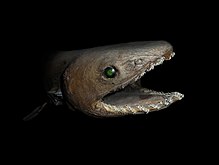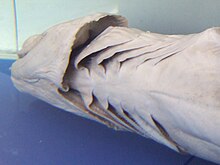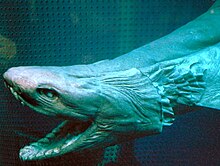Frilled shark
| Frilled shark Temporal range:
| |
|---|---|

| |
| At the Palais de la Porte Dorée | |
| Scientific classification | |
| Domain: | Eukaryota |
| Kingdom: | Animalia |
| Phylum: | Chordata |
| Class: | Chondrichthyes |
| Subclass: | Elasmobranchii |
| Subdivision: | Selachimorpha |
| Order: | Hexanchiformes |
| Family: | Chlamydoselachidae |
| Genus: | Chlamydoselachus |
| Species: | C. anguineus
|
| Binomial name | |
| Chlamydoselachus anguineus Samuel Garman, 1884
| |

| |
| Range of the frilled shark | |

The frilled shark (Chlamydoselachus anguineus), also known as the lizard shark, is one of the two
The two species of frilled shark are distributed throughout regions of the
Reproductively, the two species of frilled shark, C. anguineus and C. africana, are
Taxonomy and phylogeny
The zoologist Ludwig Döderlein first identified, described, and classified the frilled shark as a discrete species of shark. After three years (1879–1881) of marine research in Japan, Döderlein took two specimen sharks to Vienna, but lost the taxonomic manuscript of the research. Three years later, in the Bulletin of the Essex Institute (vol. XVI, 1884) the zoologist Samuel Garman published the first taxonomy of the frilled shark, based upon his observations, measurements, and descriptions of a 1.5-metre (4 ft 11 in)–long female shark from Sagami Bay, Japan. In the article "An Extraordinary Shark" Garman classified the new species of shark within its own genus and family, and named it Chlamydoselachus anguineus (eel-like shark with frills).[4][5] The Graeco–Latin nomenclature of the frilled shark derives from the Greek chlamy (frill) and selachus (shark), and the Latin anguineus (like an eel);[2] besides its common name, the frilled shark also is known as the "lizard shark" and as the "scaffold shark".[1][6]

The frilled-shark is considered a "living fossil", because its family lineage dates to the
The anatomic traits of body, muscle, and skeleton phylogenically include the frilled shark to the neoselachian clade (modern sharks and rays) which relates it to the cow shark, in the order Hexanchiformes. In addition, a genetic analysis conducted by researchers in 2016 may also suggest that the species is part of the order Hexanchiformes.[11] Nonetheless, as a systematist of biology, the ichthyologist Shigeru Shirai proposed the Chlamydoselachiformes taxonomic order exclusively for the C. anguinesis and the C. africana species of frilled sharks.[8][10] As a marine animal, the frilled shark is a living fossil because of its relatively unchanged anatomy and physique, since first appearing in the primeval seas of the Late Cretaceous (c. 95 mya) and the Late Jurassic (150 mya) epochs.[12][5] In evolutionary terms, the frilled shark is an animal species of recent occurrence in the natural history of the Earth; the earliest discoveries of the fossilized teeth of the Chlamydoselachus anguineus species of shark date to the early Pleistocene epoch (2.58–0.0117 mya).[13] In 2009, marine biologists identified, described, and classified the Chlamydoselachus africana (southern African frilled shark) of the Atlantic waters of southern Angola and of southern Namibia as a species of frilled shark different from the Chlamydoselachus anguineus identified in 1884.[14]
Habitat and distribution

The habitats of the frilled shark include the waters of the outer

In the eastern Atlantic Ocean, the frilled shark occurs off northern Norway, northern Scotland, and western Ireland, ranging from France to Morocco, the archipelago of Madeira, and the coast of Mauritania, in northwest Africa.[18] In the central Atlantic Ocean, the frilled shark has been caught along the region of the Mid-Atlantic Ridge, ranging from north of the Azores islands to the Rio Grande Rise, off southern Brazil, and the Vavilov Ridge, off West Africa. Frilled sharks tend to be very solitary organisms; interacting with multiple individuals of their kind is rare. However, in the late 2000s a large capture was made over an underwater seamount of the Mid-Atlantic Ridge, hauling in over 30 frilled sharks. The mass capture of a wide variety of male and female specimens emphasized these seamounts as a location for the mating of the species.[19] In the western Atlantic, the frilled shark occurs in the waters of New England and Georgia, in the US, and in the waters of Suriname, in the northeastern coast of South America.[20][19][14]
In the western Pacific Ocean, the frilled shark ranges from southeastern Honshu, Japan, north to Taiwan, off the coast of China, to the coast of New South Wales, Australia, and the islands of Tasmania and New Zealand. In the central and eastern Pacific Ocean, the frilled shark occurs in the regional waters of Hawaii and the coast of California, in the US, and the northern coast of Chile, in western South America.[1][18] Although it has been caught at the depth of 1,570 m (5,150 ft), the frilled shark usually does not occur deeper than 1,000 m (3,300 ft).[1][6]
Description

The eel-like bodies of C. anguineus and C. africana differ anatomically; C. anguineus has a longer head and shorter gill slits, a spinal column with more vertebrae (160–171 vs. 147), and a lower-intestine spiral valve with more turns (35–49 vs. 26–28) than does C. africana.[14] The skin color of either species ranges from uniformly dark-brown to uniformly grey.[2] In addition, C. anguineus has smaller pectoral fins than C. africana, and the mouth is narrower.[21] The recorded, maximum body-length of a male frilled shark is 1.7 m (5.6 ft), and the recorded, maximum body-length of a female frilled shark is 2.0 m (6.6 ft).[2]


The head of the frilled shark is broad and flat, with a short, rounded snout. The
The
Biology and ecology
A cartilaginous skeleton and a large
In New Zealand, the
Diet
The frilled shark eats a diet of

In hunting and eating prey that are tired or exhausted or dying (after spawn),[17] the frilled shark's physiology suggests that it may curve its anguilline body, and brace its rear fins against the water, for leverage to effect a rapid-strike bite that captures the prey.[15] The wide gape of the distended, long jaws allows devouring whole prey that are more than half the size of the frilled shark, itself.[2] The jaws' 300 recurved teeth (19–28 upper rows and 21–29 lower rows) readily snag and capture the soft body and tentacles of a cephalopod, especially with the rows of trident-shaped teeth are rotated outwards, when the jaws are open and protruded.[4] Moreover, unlike the strong bite of sharks with an underslung jaw attached below the cranium,[29] the frilled shark has a relatively weak bite, because of the limited leverage and force possible with long jaws that are directly articulated to the cranium, at a point behind the eyes.[29]
The behavior of captive specimen sharks suggests that the frilled shark also hunts with its mouth open, by using the dark-and-light contrast of white teeth and darkness to lure prey into its gaping maw;[14] and also hunts with negative pressure, to suck prey into its maw.[15] Forensic examination of frilled sharks' revealed little-to-no food in their stomachs, which suggests that the frilled shark either has a fast-rate of digestion or goes hungry in the long intervals between feedings.[17]
Reproduction
The extant species of frilled shark, C. anguineus and C. africana, do not have a defined breeding season, because their oceanic habitats register no seasonal influence from the ocean's surface;[16] the male shark reaches sexual maturity when he is 1.0–1.2 m (3.3–3.9 ft) long, and the female shark reaches sexual maturity when she is 1.3–1.5 m (4.3–4.9 ft) long.[1] The mature female shark has two ovaries and a uterus, which is in the right side of her body; ovulation occurs fortnightly; and pregnancy ceases vitellogenesis (yolk formation) and the production of new ova.[16] Both ovulated eggs and early-stage shark embryos are enclosed in chondrichthyes, ellipsoid egg-cases made of a thin, golden-brown membrane.[2]
Reproductively, the frilled shark is an
Shark and human interaction
In pursuit of food, the frilled shark usually is a
In 2004,
In 2016, consequent to the depletion of food sources caused by commercial overfishing of the
See also
References
- ^ . Retrieved 19 November 2021.
- ^ ISBN 0-520-23484-7.
- ^ Bray, Dianne J. (2011). "Frill Shark, Chlamydoselachus anguineus". FishesofAustralia.net.au. Archived from the original on 10 October 2014. Retrieved 7 October 2014.
- ^ a b c d e f Garman, S. (January 17, 1884). "An Extraordinary Shark". Bulletin of the Essex Institute. 16: 47–55.
- ^ ISBN 0-8117-2875-7.
- ^ a b Froese, Rainer; Pauly, Daniel (eds.) (2010). "Chlamydoselachus anguineus" in FishBase. April 2010 version.
- ISSN 0036-8733.
- ^ .
- PMID 17838181.
- ^ a b Martin, R.A. Chlamydoselachiformes: Frilled Sharks. ReefQuest Centre for Shark Research. Retrieved on April 25, 2010.
- PMID 33473392.
- ^ Martin, R.A. The Rise of Modern Sharks. ReefQuest Centre for Shark Research. Retrieved on April 25, 2010.
- ^ Marsili, S. (2007). Analisi systematic, paleoecological e paleobiogeographical Della selaciofauna polio-Pleistocene del Mediterraneo.
- ^ .
- ^ a b c d e f g h i Martin, R.A. Deep Sea: Frilled Shark. ReefQuest Centre for Shark Research. Retrieved on April 25, 2010.
- ^ a b c d e f g h Tanaka, S.; Shiobara, Y.; Hioki, S.; Abe, H.; Nishi, G.; Yano, K. & Suzuki, K. (1990). "The reproductive biology of the frilled shark, Chlamydoselachus anguineus, from Suruga Bay, Japan". Japanese Journal of Ichthyology. 37 (3): 273–291.
- ^ .
- ^ ISBN 92-5-101384-5.
- ^ S2CID 281370.
- ^ a b Jenner, J. (2004). Estuary to the Abyss: Excitement, Realities, and "Bubba". NOAA Ocean Explorer. Retrieved on April 25, 2010.
- ^ .
- ISBN 978-0-674-03411-2.
- ^ Martin, R.A. Hearing and Vibration Detection. ReefQuest Centre for Shark Research. Retrieved on April 25, 2010.
- ^ Collett, R. (1897). "On Chlamydoselacnus anguineus Garman. A remarkable shark found in Norway 1896". Christiania. 11: 1–17.
- ^ Machida, M.; Ogawa, K. & Okiyama, M. (1982). "A new nematode (Spirurida, Physalopteridae) from frill shark of Japan". Bulletin of the National Science Museum Series A (Zoology). 8 (1): 1–5.
- S2CID 6112274.
- S2CID 130714866.)
{{cite journal}}: CS1 maint: multiple names: authors list (link - ^ Lashaway, Aubrey. "ADW: Chlamydoselachus anguineus: INFORMATION". Animaldiversity.org. Retrieved 2022-08-23.
- ^ .
- PMID 32307702.
- ^ Nishikawa, T. (1898). "Notes on some embryos of Chlamydoselachus anguineus, Garm". Annotationes Zoologicae Japonenses. 2: 95–102.
- ^ Japanese Marine Park Captures Rare 'Living Fossil' Frilled Shark; Pictures of a Live Specimen 'Extremely Rare'. Underwatertimes.com. January 24, 2007. Retrieved on April 25, 2010.
- ^ "'Horrific' Rarely-sighted Frilled Shark Caught off south-east Victoria". The Age. Melbourne, Australia: Fairfax Media. 21 January 2015. Retrieved 21 January 2015.
- OCLC 1042901090.
External links
- ABC News video
- Chlamydoselachus anguineus, Frilled shark at FishBase
- Deep Sea: Frilled Shark at ReefQuest Centre for Shark Research
- Frilled Shark - Video at Check123 - Video Encyclopedia

